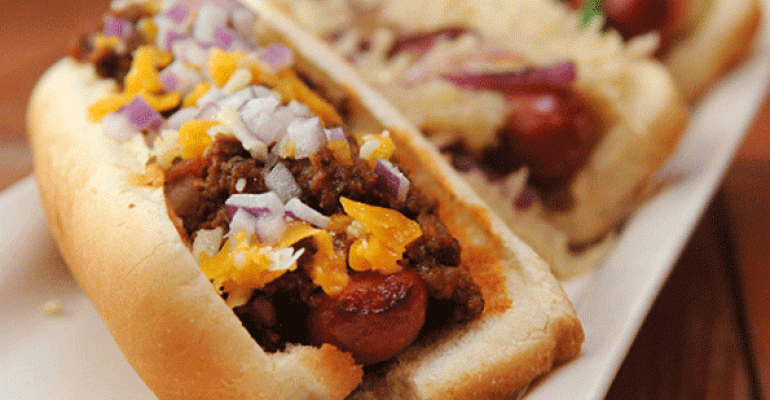
This post is part of the Food Writer’s Diary blog.
JJ’s Red Hots recently released its list of the most popular toppings on its hot dogs, and man, is it boring.
The four-year-old upscale hot dog and sausage purveyor has released the list for the past three years at the end of June, based on sales from July through June. That makes sense, since summer is the height of hot dog season: Some seven billion of them are eaten in the United States between Memorial Day weekend and Labor Day, according to the National Hot Dog and Sausage Council.
The year ending June 2015 saw some surprise condiments: Pimento cheese was in 5th place, and both salsa and caramelized onions made the top 10.
But not this year. The 2016 list is one of the least interesting things I’ve seen in a long time.
This doesn’t bode well for America. It’s an indicator that we’re stressed out.
 I know a little bit about this: I actually wrote the entry on comfort food in the second edition of the Oxford Encyclopedia of Food and Drink in America, and trust me: a hot dog with mustard is comfort food for many Americans, and that’s what people eat when they’re upset.
I know a little bit about this: I actually wrote the entry on comfort food in the second edition of the Oxford Encyclopedia of Food and Drink in America, and trust me: a hot dog with mustard is comfort food for many Americans, and that’s what people eat when they’re upset.
As I wrote in that encyclopedia, comfort food “can be anything that takes its eaters to a safe emotional place, that allows them simply to turn off their brain and chew.”
After the terrorist attacks of September 11, 2001, restaurants reported an increase in the sale of hamburgers and pasta. The bar menus of restaurants in lower Manhattan started offering pizza. Soup sales shot up at some places, too.
Then when the economy collapsed in 2008, restaurants started promoting items like meat loaf with mashed potatoes and macaroni & cheese. Burgers and fried chicken were pushed, too. As the recession continued, that’s when we saw the emergence of meatballs, hot dogs and other sausages, red velvet cake and all those grilled cheese sandwich concepts that came and went.
Now JJ’s Red Hots has just two brick-and-mortar locations and a few mobile operations, all in Charlotte, N.C., so its guests’ return to plain relish and cheese is hardly a definitive sign of social malaise: The presidential elections are a clearer indicator of that.
But maybe it does cast the current expansion of hot dogs in a bleaker light.
 Hot dogs have been in play for the past year-and-a-half or so. Sonic Drive-In, which started selling hot dogs in 2010 (remember 2010? Not a good year economically), introduced miniature “Lil’ Doggies” early in 2015, Wienerschnitzel did a summertime promotion of five different chili cheese dogs and around the same time Pizza Hut introduced its Hot Dog Bites pizza, which had 28 pigs-in-a-blanket pinwheeling off the crust. Then of course in February Burger King rolled out Oscar Mayer wieners across the country.
Hot dogs have been in play for the past year-and-a-half or so. Sonic Drive-In, which started selling hot dogs in 2010 (remember 2010? Not a good year economically), introduced miniature “Lil’ Doggies” early in 2015, Wienerschnitzel did a summertime promotion of five different chili cheese dogs and around the same time Pizza Hut introduced its Hot Dog Bites pizza, which had 28 pigs-in-a-blanket pinwheeling off the crust. Then of course in February Burger King rolled out Oscar Mayer wieners across the country.
Back in May I spoke with Hagop Giragossian, one of three founding partners, in late 2010, of Dog Haus in Pasadena, Calif. Now up to 21 locations, Giragossian was raving about the expansion of the premium hot dog scene. Dog Haus has done Thai curry dogs and foie gras dogs, but as you might expect, spicy Italian sausage and bratwurst are their most popular dogs. In third place is the not-at-all-surprising bacon-wrapped dog.
Does the boom of boring hot dogs spell bust for America? Oh, I don’t know, but there are signs that things are looking up. My colleague Jonathan Maze is hearing talk that BK’s hot dog sales are slowing.
Contact Bret Thorn at [email protected].
Follow him on Twitter: @foodwriterdiary

